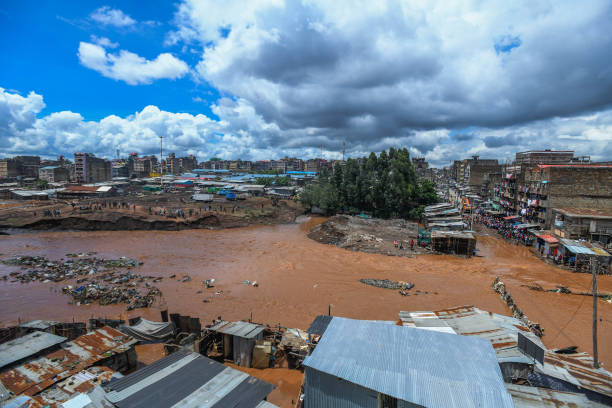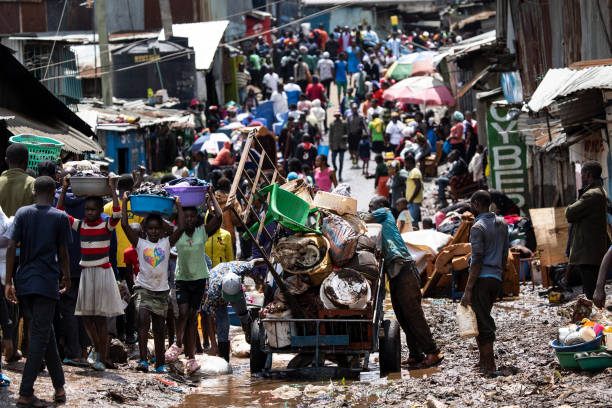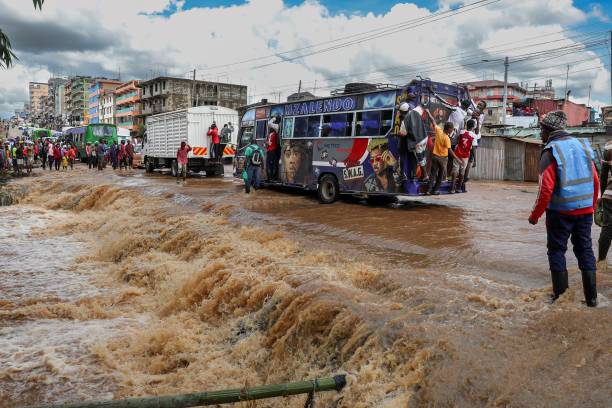The heavy rains in Kenya have come with a lot of destruction and suffering. The downpours started in March and, up to now, have claimed the lives of at least 200 people. Over 200,000 people have been rendered homeless. Thirty thousand families have been displaced from their houses. Entire communities are devastated. Houses are destroyed and roads are washed away. Many vulnerable people have lost everything.
It is the city of Nairobi, the capital city of Kenya, that has sustained unimaginable destruction by the floods. Over 147,000 residents have been hugely affected as the number of families left stranded and homeless is over 21,000. Unfortunately, some lives have been lost to the floods in the city. Hundreds of thousands of Kenyans in Nairobi are actually suffering at the moment because of loosing homes, jobs, and stability in life.
Amidst this crisis, Nairobi County Governor Johnson Sakaja has pledged that the government will resettle those displaced to safer ground. He has sternly warned flood victims against returning to the now hazardous areas they were evacuated from, as the county coordinates resettlement efforts with national authorities. Sakaja understands the dire need to find these people more secure housing solutions.
“I am urging the affected people, do not go back where you came from, where our houses have been washed away by the flood waters”
Nairobi Governor Sakaja

Even the neighboring Kajiado County has not been spared. Over 200 families there were rendered homeless after their houses in Ngurumani and Kitengela West were submerged.
Lakes, rivers and water catchment areas have overflowed, causing chaos in many of the city’s informal settlements. Residential areas like Kibera and Mathare have been inundated, leaving tens of thousands homeless and displaced. Aid agencies are rushing emergency relief supplies, but distribution has been extremely challenging with so many roads and bridges washed away across the country.
The death toll continues to climb daily as more areas become submerged. Meteorologists warn the heavy rains causing this catastrophic flooding may persist for several more weeks before subsiding. As such, the suffering across Kenya’s flood zones seems likely to tragically worsen before the situation improves.
Sakaja underscored the urgent need for affordable housing initiatives, as the floods have underscored the danger of residing in low-cost but high-risk areas. 🏡 He expressed gratitude to the multi-agency teams, including the 3,500 Green Army youths, for their efforts in unclogging drainages and clearing debris, which mitigated the flood’s impact. 👷♂️

The governor also called for striking doctors to resume work, stating that negotiation can resolve any issues, while the county has started reconstructing 12 bridges destroyed by the floods to ensure children can safely access schools. 🌉🏥
National Intervention and Relief Efforts At the national level, the Kenyan government has committed to coordinating assistance and implementing vital mitigation measures. Interior Principal Secretary Raymond Omollo affirmed that support would be channeled through National Government Administration Officers collaborating with community stakeholders like elders, youth, women, and Nyumba Kumi initiatives.
During a visit to the Kiamaiko Ngundu area in Mathare Constituency, where demolitions of structures on riparian land were ongoing, Omollo announced plans to aid affected individuals through cash transfers, affordable housing, and social housing initiatives.
Since Thursday, more than 100 people have voluntarily relocated from flood-prone areas like Dandora, Mukuru Kwa Reuben, and Soweto in Nairobi County. Additionally, 138 camps have been established to accommodate residents from high-risk zones, with 33 in the capital alone.

To support affected communities across various counties, including Busia, Homa Bay, Kisumu, Machakos, Nairobi, Nakuru, and Murang’a, the government has provided essential food supplies such as rice and beans. 🥫
As the nation grapples with the aftermath of the devastating floods, concerted efforts from authorities and stakeholders are crucial in providing immediate relief and long-term solutions to mitigate the impact of such natural disasters on vulnerable populations.
Opere, A. (n.d.). Title of document. Retrieved from University of Nairobi Repository: http://erepository.uonbi.ac.ke/bitstream/handle/11295/66135/Alfred%20Opere.pdf
- Westerman, A. (2024, May 2). Kenya floods: Officials criticized over response. NPR. https://www.npr.org/2024/05/02/1248726991/kenya-floods-official-response
- Jones, S. (2024, May 3). Kenya floods: Marginalized communities hit hardest. BBC News. https://www.bbc.com/news/world-africa-68898731
- ReliefWeb. (2024, May 2). Kenya floods threaten marginalized people. Retrieved from ReliefWeb: https://reliefweb.int/report/kenya/kenya-floods-threaten-marginalized-people
- International Federation of Red Cross and Red Crescent Societies. (2024, May 1). Kenya floods: DREF operation MDRKE058. Retrieved from ReliefWeb: https://reliefweb.int/report/kenya/kenya-floods-dref-operation-mdrke058
- Opere, A. (n.d.). Title of document. Retrieved from University of Nairobi Repository: http://erepository.uonbi.ac.ke/bitstream/handle/11295/66135/Alfred%20Opere.pdf




I don’t think the title of your article matches the content lol. Just kidding, mainly because I had some doubts after reading the article.
I don’t think the title of your article matches the content lol. Just kidding, mainly because I had some doubts after reading the article.
Your point of view caught my eye and was very interesting. Thanks. I have a question for you.
Your point of view caught my eye and was very interesting. Thanks. I have a question for you.
Thanks for sharing. I read many of your blog posts, cool, your blog is very good.
Great article! I really appreciate the clear and detailed insights you’ve provided on this topic. It’s always refreshing to read content that breaks things down so well, making it easy for readers to grasp even complex ideas. I also found the practical tips you’ve shared to be very helpful. Looking forward to more informative posts like this! Keep up the good work!
Thanks for sharing. I read many of your blog posts, cool, your blog is very good.
Thanks for sharing. I read many of your blog posts, cool, your blog is very good. https://accounts.binance.com/en/register?ref=JHQQKNKN
Can you be more specific about the content of your article? After reading it, I still have some doubts. Hope you can help me.
Your point of view caught my eye and was very interesting. Thanks. I have a question for you.
Can you be more specific about the content of your article? After reading it, I still have some doubts. Hope you can help me.
Thanks for sharing. I read many of your blog posts, cool, your blog is very good.
Thanks for sharing. I read many of your blog posts, cool, your blog is very good.
Your point of view caught my eye and was very interesting. Thanks. I have a question for you.
Thank you for your sharing. I am worried that I lack creative ideas. It is your article that makes me full of hope. Thank you. But, I have a question, can you help me?
Your article helped me a lot, is there any more related content? Thanks!
I don’t think the title of your article matches the content lol. Just kidding, mainly because I had some doubts after reading the article.